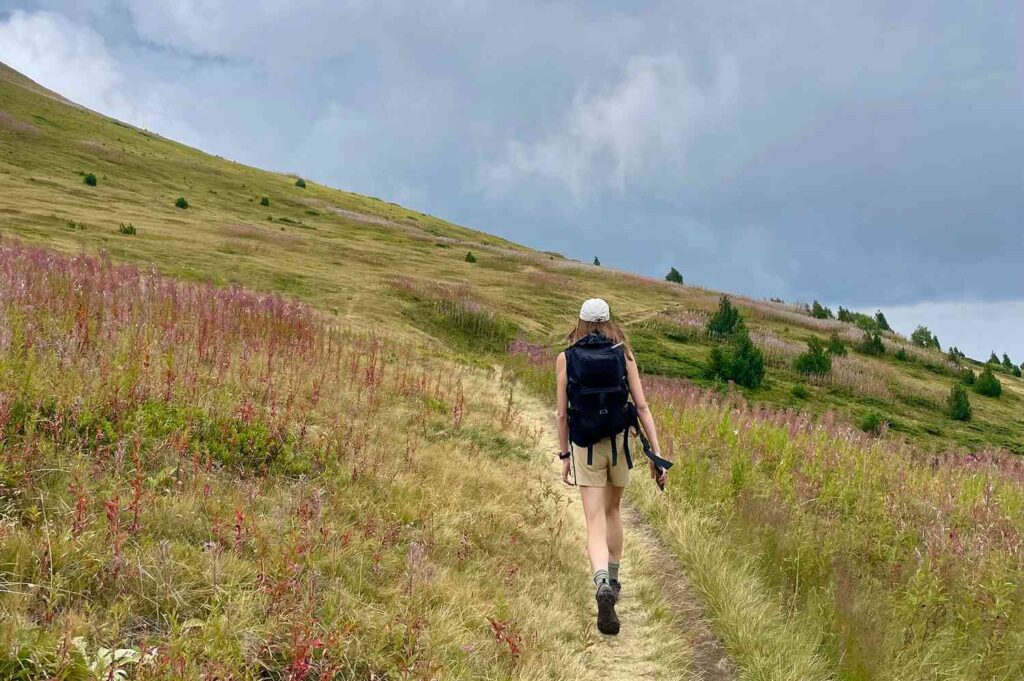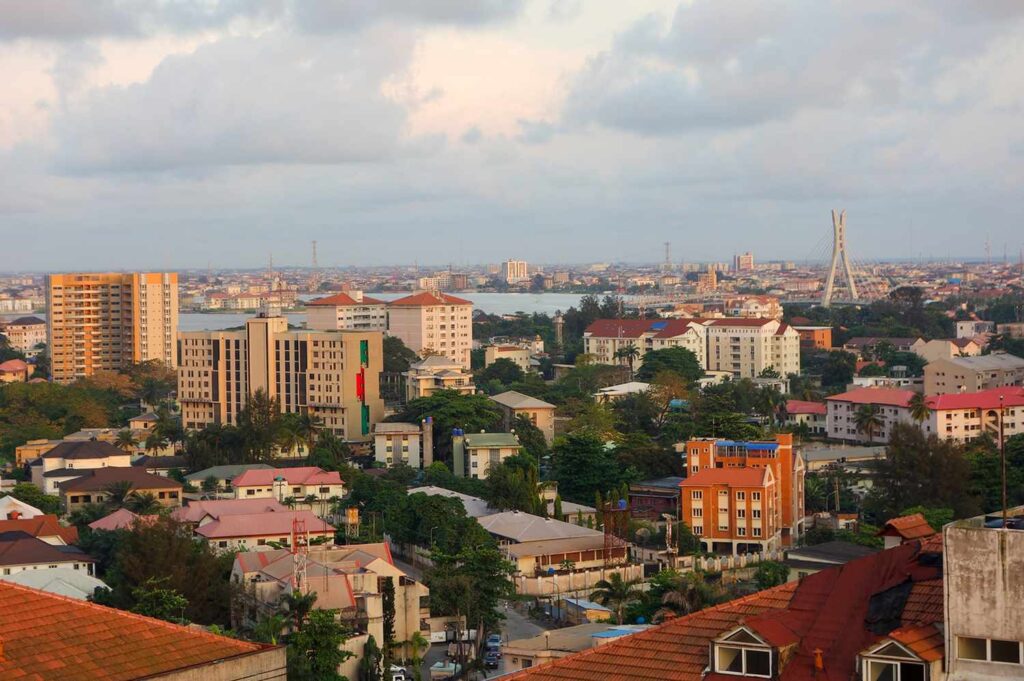:max_bytes(150000):strip_icc():format(jpeg)/TAL-header-clodagh-hiking-trail-HIKEBALKANS1124-82c1186a47694c08be6f7ab7b8d2cebb.jpg)
On the summit of Kosovo’s highest peak, nothing stirred. Starkly sublime mountains stretched out on all sides, towering over glacial lakes and fields of wildflowers. As we lay on the rocks, recovering from a punishing final push, it seemed like we’d fallen out of time.
The 8,714-foot Gjeravica mountain — the one we’d just climbed — sits in the Accursed Mountains, which straddle the borders of Kosovo, Montenegro, and Albania. For much of the past century, this embattled part of southeast Europe was a no-go zone, but tourists are now coming in increasing numbers to discover its wilds.
That’s partly down to the Peaks of the Balkans, a long-distance transnational hiking trail that was launched in 2012 by a German development organization and runs for 119 miles, crisscrossing the three countries’ borders. Drawn to remote places, I’d wanted to explore it for years — and so, dragging along my game running partner, Cristina, who’d never done a multiday hike, we set out in mid-August for a seven-day loop of the trail.
Courtesy of Cristina López
Our journey had begun five days earlier in Albania’s capital, Tirana. From there, we’d hopped a bus to Shkodër, and the next day, took a minivan to Theth — a touristy village known for the Blue Eye: a preternaturally turquoise natural pool. It’s possible to do a guided tour, but we opted to go it alone, carrying all we needed and downloading offline hiking maps so we wouldn’t go astray. The trip was shockingly cheap: Our average daily budget all in was $40 per head.
The first day of hiking was a baptism of fire. Not only is the popular Theth-Valbona route one of the trail’s steepest, but temperatures also hit the mid-90s, igniting wildfires. After many strenuous hours rising through dark forests, we emerged onto the dazzling Valbona Pass before a long descent hopping out of the way of horses bearing hikers’ bags. In Valbona, there was a dried-up riverbed full of rocks to navigate to our guesthouse, where we promptly collapsed after restoring our spirits with wine and freshly caught trout.
To avoid the searing heat, for the rest of the trip, we set out just after dawn, arriving at our destination early afternoon following five to eight hours of hiking. Owing to the relatively low altitudes, beyond the odd scramble, the trail is within reach of the moderately fit. And rarely have I seen such diverse landscapes while hiking — the scenery reinventing itself each day, as forests gave way to fields of cabbages, pristine lakes reiterating the clouds, and old military tracks with no company beyond flocks of sheep.
Most of the time, we were never exactly sure when we’d crossed a country border. The lack of control posts was even more remarkable given these frontiers were some of the most contested in the world during the Yugoslav Wars in the 1990s. Now, we felt a rare sense of peace as we lazed in the grass over picnics or cut along narrow ridges with views for miles.
Accommodations on the trail are straightforward, though there’s no shortage of hearty food. We stayed in A-frame cabins, traditional fortified dwellings called kulla, and — our base for Gjeravica, a common add-on to the official trail — the kind of striking guesthouse I’d never expected to see in Kosovo, the least developed country on the route.
Having stumbled upon it by chance on Google Maps, and tracked it down on Airbnb, we were so keen to visit that we hiked the usual 9.5-mile trail that day — and carried on for three hours over a vertical hill to reach it.
Courtesy of Cristina López
Cabin on a Rock’s owner Sali Shoshi, an architect, had done everything by hand, working with reclaimed materials and installing an off-grid solar system. We were out in the sticks, but a shepherd delivered a banquet: salad, spiced chicken, mounds of bread, and a vat of sheep’s milk. In a luxurious touch, there was a minibar and a fine terrace for stargazing.
“This part of Kosovo is something truly special,” Shoshi told Travel + Leisure. “The landscapes are untouched and peaceful. Plus, it’s a place where the ancient traditions of the highlanders are still very much alive. Here, welcoming guests isn’t just a polite gesture; it’s almost sacred.”
With a background in heritage and tourism, Shoshi witnessed a sea of change since the 1998–1989 Kosovo war. Locals had emerged from it full of solidarity and a love of freedom. “Today, when you visit Kosovo, you won’t find despair,” he said. “You’ll find a zest for life.”
At guesthouses all along the way, that zest for life was palpable. One hostess tried to refuse payment for lunch when our cash ran low. At another, in a scene out of a film by Emir Kusturica, famous for capturing the larger-than-life Balkan people, our hostess’ whole extended family called for a visit, endlessly circling the property on a new off-road buggy. Having tended to us — and them — late at night, she left to make the drive back to her baby.
As Virtyt Gacaferri, co-founder of tour company Balkan Natural Adventure, told T+L, the trail has been a lifeline for locals. “It has transformed a mountainous, pastoral, poor region into a model of tourism,” he said. “There’s a lot of money coming in, and everybody’s profiting.” His company loaned one family funds to launch a guesthouse in the rural Albanian village of Çerem, and three years on, they’ve already repaid it. “It really makes me quite emotional. They were poor and now they’ve got pride, they work, they make their own money.”
After British and German hikers, Americans are now Gacaferri’s third-biggest market. As the trail has grown, the adventurous trekkers of the start have ceded to a more diverse clientele, some of whom miss the mod cons. For others like us, the simplicity is magical.
Clodagh Kinsella/Travel + Leisure
After a strenuous last day mostly downhill — at just shy of 16 miles, the longest of our hike — we emerged in Montenegro above the lakeside town of Plav, retreating to a sweet stilt cabin with private lakeside access. Tacking on a week of R&R post-hike is common. Thanks to its pristine beaches, Albania is being touted as Europe’s hottest new destination, but Montenegro isn’t far behind — and we opted for a road trip across the country.
From the moment we arrived in Durmitor National Park, we were under its spell. Hiking the lunar terrain (where we bagged another peak, Bobotov Kuk), then staying in a geodesic dome on a vineyard near capital Podgorica, we saw many countries for the price of one. The trip ended in Perast, a stunning, traffic-free coastal village where we lunched at oyster farms for a pittance and dived off the concrete into the sea.
Perched at one of its bars, as cruise ships from the nearby tourist hub of Kotor plied the bay, I wondered how long the region could stay under the radar. With Montenegro entering the last phase of talks to join the European Union, not long — but until then, it offers a glimpse of a Europe I thought had gone. An entering it on foot was a voyage to remember.
Exploring the Peaks of the Balkans
Courtesy of Cristina López
The Peaks of the Balkans is best walked from June to October, and hikers can join the trail in Albania, Kosovo, or Montenegro. Border permits are essential and can be bought through Balkan Natural Adventure, which offers a range of self-guided and guided tours (many people also camp). For more information, see the Facebook page dedicated to the trail.


